Mark Sisson's Blog, page 379
June 26, 2012
Why Did My Cholesterol Go Up After Going Primal?
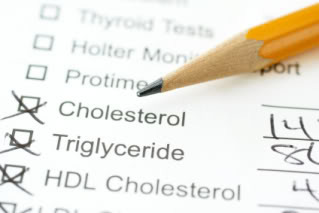 While the majority of people who go Primal see their blood lipids improve, a significant minority do not in the short term. They see LDL cholesterol skyrocket, or their total cholesterol increase, and sometimes triglycerides even mysteriously elevate despite a low-carb intake.
While the majority of people who go Primal see their blood lipids improve, a significant minority do not in the short term. They see LDL cholesterol skyrocket, or their total cholesterol increase, and sometimes triglycerides even mysteriously elevate despite a low-carb intake.
What’s going on here? Should you go on statins? Should you add grains back in? Should you start jogging for a couple hours every night? Should you even worry about it?
Before you freak out, let’s go over a couple things:
Even though it may be sufficient to get your doctor to write a statin prescription, keep in mind that a total cholesterol level of between 200 and 240 is associated with the lowest risk of all-cause mortality (PDF).
If it’s LDL you’re worried about, total particle count is the thing to watch. Standard lipid panels, including LDL-C (amount of cholesterol inside the particles) and total cholesterol, can certainly give you an idea of your particle count, but you might want to read up on advanced lipid tests, too, if you’re not satisfied. Confirm that your “elevated cholesterol” is actually an issue.
That said, seeing a host of beyond-end-range numbers on your lipid test can be scary. It can also be confusing, especially if everything else appears to be going so well for you health-wise. So today, I’m going to explore a few of the reasons why your cholesterol might have gone up after going Primal. Some reasons will quell your fears, while some may provide avenues for further experimentation. At any rate, you’ll learn something.
You’re losing weight.
Going Primal often means weight loss. This is a good thing, as excess body fat is unhealthy. We want to increase lean mass while decreasing fat mass. Usually, such weight loss leads to improvements in lipid numbers. If you get your cholesterol checked when you’re fifty pounds overweight, lose it all, and check it again once your weight stabilizes, your numbers will likely have improved. That’s what the studies tend to suggest.
When you lose weight the good way – by burning body fat rather than lean mass – you are consuming pure animal fat. Say you’re dropping a pound of body fat every four days or so – that’s releasing a stream of 3500 calories-worth of animal fat into your blood stream as triglycerides and free fatty acids. If you take a snapshot of your lipids in the midst of this rapid weight loss, there’s a chance that your numbers will look off. Triglycerides in particular may be up, way up (since your blood is now full of them, newly liberated from adipose tissue).
Solution: Recheck once your weight has stabilized.
You’re deficient in some key micronutrients.
Yeah, the food we get to eat on Primal is delicious and incredibly nutritious, but that doesn’t mean we’re completely immune to nutritional deficiencies, especially considering a lot of the food we stopped eating – grain products like breakfast cereal and granola bars, and processed foods of all kinds – were our most reliable sources of vitamins and minerals thanks to the wonders of fortification.
A few of the most common include:
Iodine - Iodine is required for production of thyroid hormone, and too large a reduction in thyroid activity can lower the expression of LDL receptors. Without enough LDL receptors, LDL doesn’t get cleared from the blood. Primal eaters who give up iodized salt for sea salt without making up the difference with adequate seaweed and seafood may be missing out on iodine (eating tons of goitrogenic cruciferous veggies at the same time might compound the problem).
Copper – Copper deficiency is associated with elevated levels of LDL, as well as increased particle number. Both oysters and ruminant liver are excellent sources of copper. You eating your offal and shellfish?
Selenium – Selenium deficiency is associated with reduced LDL receptor activity (and subsequent elevated LDL levels). Salmon, kidneys, and brazil nuts are great sources of selenium.
Check out my post on micronutrient deficiencies (plus this one) to see what else you might be missing.
Solution: Eat some liver, shellfish, seaweed, salmon, brazil nuts, and check your diet against a nutritional database for a couple weeks to see if you’re hitting all your targets.
You’re grazing all day.
People coming from a standard Westernized diet are usually ravenously hungry at all times. They have trouble going several hours between meals. And then they switch to Primal eating, their hunger issues improve, but the snacking remains. It’s tough to beat. After all, we live in a culture of snacking (those of us in the US, at least). If you work in an office, snacks abound. Donuts are always being trotted in and paraded about. Jars of candy beans and M&Ms adorn every second desk. People keep “snack stashes” in their desk drawers.
And so we snack. Instead of giving our bodies and digestive systems a break, we remain in “fed” mode. As soon as our bodies start to get a handle on the nutrition we’ve recently ingested, we send in some more – just as our guts were about to crack a beer and take a load off. Admittedly, I don’t have any studies to reference, but I don’t think it’s a stretch to say that staying in the fed state hampers our ability to utilize the fatty acids in our blood (since there’s a constant influx of nutrients, why bother burning what we have?), and thus might cause elevated cholesterol.
I’m not saying you have to fast, because you don’t. But I would caution people against grazing – against always having something on hand to absentmindedly munch on, against gallivanting around with a sackful of salted nuts on your belt, against eating 6-12 small “meals” per day so as to avoid imminent muscle catabolism. Just eat real meals, substantial plates of food that keep you sated for four to five hours a pop.
Solution: Eat real meals.
Your activity levels don’t match your carb intake.
While I’m a proponent of tailoring your workouts so that you don’t require a high-carb diet, many people enjoy maintaining a high level of sustained intensity in their workouts. That’s cool. I get it. Just don’t think you can stay very low carb and enjoy good health while maintaining high-intensity endurance or metcon training on a daily basis.
What’s this have to do with cholesterol? Well, if you’re hitting the metcons regularly without the necessary glucose infusions, your body conserves what glucose is available. We need some glucose for brain function (ketones and other sources can handle a lot of our brain’s needs, but not all of it), so in order to preserve what little glucose is available, T3 thyroid hormone is reduced. Normally, T3 increases glucose utilization, but when the body doesn’t have enough due to mismatched exercise output and carb input, T3 must drop to conserve glucose. Unfortunately, this lowered T3 can lead to lowered LDL receptor activity, which leads to increased lipid levels.
Solution: Align your activity levels with your carb intake.
You’re still not moving frequently at a slow pace.
I’ve said it before, and I’ll say it again: low level aerobic activity in the form of walking, hiking, easy cycling, or even light rowing is absolutely essential. There’s a reason it forms the base of my Primal Blueprint Fitness pyramid. When you go for a good-sized walk, you’re not burning calories. You’re not blasting your abz, bunz, and gunz. You’re not vomiting on yourself from overexertion. It’s not exciting. It won’t make a good Youtube video set to Linkin Park. But what you will be doing is utilizing those free fatty acids that might be throwing off your lipid panels.
In one study, patients who walked briskly were far less reliant on cholesterol, blood pressure, and diabetes medications. Those who took the longest walks at the briskest pace were the least likely to have LDL cholesterol high enough to warrant statins. In another, brisk walking was enough to reduce triglycerides and LDL particle count in overweight women.
Lifting heavy things and sprinting once in awhile are excellent acute stressors that elicit fantastic health and performance benefits, but constant low-level movement is the foundation of it all, especially if you’re eating more fat and trying to become a true fat-burning beast.
Solution: Do I even have to say? This isn’t optional. Go for a walk!
You’re not lifting heavy things.
Cholesterol isn’t out to get us, you know. We don’t manufacture the stuff to commit slow suicide. It actually serves a purpose in our bodies. From cholesterol, we produce steroid hormones, sex hormones, and make vitamin D (with a little help from the sun, of course). With cholesterol, lipid particles transport nutrients and antioxidants to various parts of the body. Research shows that, following weight lifting, we also use cholesterol to repair and rebuild muscles.
In fact, acute bouts of resistance training can cause large reductions in blood lipids. One study found that total cholesterol was reduced up to 48 hours after a single weight training session. Another (PDF) found that the cholesterol reduction persisted at 72 hours post workout. Interestingly, the drop in cholesterol in both studies accompanied a rise in creatine kinase, an indirect marker of the degree of muscle damage caused by strength training. The fact that the effects persist for days after a single bout of weight training suggests that regularly lifting heavy things can effectively manage your cholesterol.
Eating fat can increase cholesterol. Not in everyone, not even in most, but enough people see a (usually neutral) increase in cholesterol when they start eating more fat. That’s all well and good as long as you make use of it. Lifting heavy things, whether it’s your own bodyweight, someone else’s, a barbell, a log, or a machine, breaks down and then repairs muscle. Cholesterol is required to repair muscle, to make it stronger. To make you stronger. If you squander the opportunity to use all that cholesterol by failing to lift anything heavy, don’t be surprised if things get a little screwy with your blood lipids.
Solution: Lift heavy things at least twice a week.
Notice a common thread? Most of these reasons for elevated cholesterol are easily testable. And if you can test them, you can probably find a solution. Think back to the recent series on self-experimentation if you need some pointers.
That’s what I’ve got. What about you? Has your cholesterol increased since going Primal? Do any of these sound familiar? If so, how are you going to approach the issue – if at all? Or, if something else was causing your increase, tell us how you fixed it. Thanks for reading, everyone!
Visit Mark’s Daily Apple Tomorrow to Grab Your Copy of the Upcoming Book The Primal Blueprint 90-Day Journal and Claim Your Free Gifts!

June 25, 2012
Dear Mark: Personalizing the Primal Blueprint
 Primal life is good. You’ve lost some weight, improved some health markers, enjoy steady even energy throughout the day, and you finally look forward to exercise (and movement in general) for the first time in a long while. You love the food, and the compliments you’ve started receiving since beginning to eat it, and you’re generally content, but something’s missing. It’s not that you aren’t satisfied; it’s that you’re curious about what else you can tweak to make your body work a little differently. You want to see what makes your body tick, and why, down to the very last detail. I get that.
Primal life is good. You’ve lost some weight, improved some health markers, enjoy steady even energy throughout the day, and you finally look forward to exercise (and movement in general) for the first time in a long while. You love the food, and the compliments you’ve started receiving since beginning to eat it, and you’re generally content, but something’s missing. It’s not that you aren’t satisfied; it’s that you’re curious about what else you can tweak to make your body work a little differently. You want to see what makes your body tick, and why, down to the very last detail. I get that.
Luckily for you, your experience and the resources in this community give you the necessary wherewithal to find out. Let’s go to the question that prompted this post, shall we?
Dear Mark,
I’m really digging your recent posts on self-experimentation. I’ve been conducting experiments on myself much in the way that you describe for a few years now. I’ve had great success with intermittent fasting, and have found just the right eating window and frequency of IFing that works for me. I’m going to give biphasic sleep a try to see how little sleep I can get away with without sacrificing ANY mental acuity, energy, etc.
I know you and the Primal Blueprint are all about getting the best results with as little pain, suffering and sacrifice as possible. I’m wondering what other kinds of tweaks I might try out to help me personalize my Primal way of life. I know some people do better with dairy than others, so I’ll probably be testing that out, too. Although I seem to do fine with dairy I’ve never really tried going without it, so I’m going to give it up for a period and do it systematically – recording results and so forth. What else should I experiment with? Thanks for your thoughts. Grok on!
Steven
Glad to hear you’ve found success, particularly by conducting your own personal experiments. It’s pretty powerful stuff, huh?
Further tweaks? Sure, I got those. What follows are some of the things that fall within the Primal Blueprint way of life, but that are individual-specific and customizable. I’m not going to get too deep into how to put together an experiment for each thing, since I gave you guys the tools to do that with the self-experimentation posts, but this will give you a nice head start.
Dairy
Dairy can be a confusing food for a person to assess. You give up (or add) dairy, and notice results. What’s the explanation? Was it the lactose? The casein? The pasteurization? The animal’s feed? Without getting into more detail, we’ll never know, because “dairy” is so general a term. All it indicates is “food that comes from the milk of mammals.” We probably need to dig deeper and get more specific.
Test the removal or addition of dairy in general to your diet. Goat, cow, butter, cream, milk – it’s all fair game. Try or remove it all and put together an experiment.
Grass-fed/pastured (it can be difficult to find exclusively grass-fed dairy, so pastured, wherein animals get access to pasture plus supplemental feed, is a potential concession) dairy versus conventional/grain-fed dairy. Does dairy from grass-fed animals make a difference to you?
Animal versus animal. Cow milk (or butter, or yogurt, or any other product) got you down? See if goat or sheep dairy elicits a different response.
Fermented versus unfermented. Many people find they do better on yogurt and kefir than milk and cream.
Butter versus ghee. Find out how sensitive you really are to the dairy proteins.
A1 beta casein versus A2 beta casein. Goat, sheep, and Jersey cow dairy contain A2 beta casein, while Holsteins and other conventional dairy cows have A1.
Dairy fat versus dairy protein versus dairy sugar. What’s bothering you – the fats, the proteins, or the lactose?
Nuts
Because they’re calorically dense, delicious, low-carb, and fit nicely in your hand, nuts are a common weight loss stall food. Not everyone, however, has problems with nuts. Are you one of them?
Nuts versus no nuts. Simple stuff.
Low nuts versus no nuts. Maybe it’s not the nuts themselves that are the problem, but the vastness of your nut intake. Try comparing a low nut intake to a zero nut intake.
In-the-shell versus shelled. For those who have trouble with overconsumption of nuts, I’m a proponent of keeping them in the shell until you want to eat them. That way, you can’t just grab a handful of walnuts and pop ‘em in your mouth; you have to work for your nuts, just like Grok.
High omega-6 versus low omega-6. Compare walnuts (high omega-6) to, say, macadamias (low omega-6), or pine nuts (high) to hazelnuts (low).
Soaked versus unsoaked. Does soaking nuts affect your ability to eat and enjoy them?
Fruit
Fruit has sugar, and we generally recommend avoiding sugar. Then again, fruit’s a whole food that also has phytochemicals and minerals and soluble fiber and vitamins, and we generally recommend eating whole foods. What’s the deal?
Fruit versus no fruit. Again, easy.
Low fruit versus no fruit. Is fruit the problem, or too much fruit?
High-fructose fruit versus low-fructose fruit. Check the table (PDF) to see which is low and which is high.
Types of fruit. Stone fruits versus berries, for example.
Offal and Other Odd Bits
Many people do fine without adding the weird bits of the animal to their diets, but plenty of people find that the addition improves things. See where you stand.
Offal twice a week. Does eating an animal’s organ meat twice a week change anything?
Liver versus no liver. Are you missing out on nature’s multivitamin?
Offal versus muscle meat. What would happen if you switched out your muscle meat for organs?
Bone broth versus no bone broth. Should you be making bone broth on a regular basis?
Bone marrow versus other fats. Evidence suggests that bone marrow was one of the first animal foods we scavenged; what happens if you replace your butter with, say, bone marrow?
Other Food Tweaks
For everything that doesn’t quite merit its own section.
Nightshades versus no nightshades. Find out if you have a sensitivity to foods from the nightshade family, including tomatoes, peppers, potatoes, eggplants, cayenne, paprika, and pimentos.
FODMAPs versus no FODMAPs. Are you sensitive to fermentable, oligosaccharides, disaccharides, monosaccharides, and polyols?
80/20 versus 90/10 versus 100/0 (and so on). What happens as you descend the sliding scale into more and more cheats and sensible vices?
Alcohol versus no alcohol. Does it affect your weight, your energy, your digestion, your sex life?
Eating Habits
When you eat, where you eat, and how you eat can all have different effects. Some people do best with a hearty breakfast, some enjoy eating on the run, and some thrive on just one meal a day.
Breakfast versus no breakfast. Do you need to eat breakfast? Do your energy levels improve when you eat it?
Fasting. In light of the recent women and IF talking point, how about trying it out for yourself?
Sit down meal versus eating on the run. What would happen if you sat down to a real meal every day instead of eating on the run? Would it be more satisfying (with less food)?
Eating alone versus eating with companions. Is the food more satisfying when you eat it with friends and family?
Eating before bed. Does a meal before bed affect your sleep, and if so, does it affect it negatively or positively? Experiment with different timing (1 hour, 2 hours, 3 hours before bed).
Exercise and Sleep
Exercise isn’t as simple as “go move.” That can certainly work, and it’s where I’d start, but you can get a little more specific than that. Sleep is tougher, because, well, “go sleep” is pretty much what sleep is all about. Still, you can fine tune that, too.
Workout timing. Are morning workouts more productive? More sustainable? Is your strength better in the evening? Worse? Test it.
Workout fueling. Test whether eating before a workout helps your performance.
Workout composition. Are you lifting heavy things? No? Try a couple days a week. Are you walking enough? No? Walk half an hour every day. Change the makeup of your workouts to see how they affect your results.
Sleep duration. Test whether or not you need six, seven, eight, nine or ten hours of sleep a night.
Absolute darkness at night. How does blacking out all windows in your room affect your sleep? Do you sleep harder but wake up later?
Now, obviously, this is just fine tuning of a fairly well-oiled machine that’s already humming along, as the PB is tried and tested and proven. However, there’s always room for improvement – or at the very least, some lateral movement that while not necessarily improving things or making them worse, does give you a different perspective that can be valuable and instructive. Ultimately, we all must personalize the PB and make it our own. These are just a few ways for us to do that.
So, if you ever get the hankering for some more self experimentation, or if something isn’t working for you, come back to this post for inspiration and ideas. There was no way for me to cover all of the possible permutations of variables, but I trust you’ll figure it out on your own.
Let’s hear from you guys and get some dialogue going. If you’re planning on testing one or more of the variables listed in this post, or anything else, tell us how you plan on doing it in the comment section. Thanks for reading!
Visit Mark’s Daily Apple on Wednesday, June 27, to Grab Your Copy of the Upcoming Book The Primal Blueprint 90-Day Journal and Claim Your Free Gifts!

June 24, 2012
Weekend Link Love
 Our favorite The Atlantic contributor doubles down on her campaign against low-carb, high-fat, erecting a pretty impressive strawman in the process.
Our favorite The Atlantic contributor doubles down on her campaign against low-carb, high-fat, erecting a pretty impressive strawman in the process.
I’ve been railing against the idea that we need to be constantly drinking water ever since this one time during the Kona Ironman. See, I lost my hold on third place down the stretch because I had to stop to relieve myself of the 30 bottles of Exceed/Gatorade/water I’d downed out of fear of dying of dehydration. It was the longest piss I ever took. Famous exercise scientist Tim Noakes agrees with me.
Dishwashers get dishes cleaner than hand washing, but does it actually matter for our health?
In case you needed another reason to use full-fat salad dressings, a recent study found that low-fat or no-fat salad dressings fail to help us extract nutrients from the vegetables in the salad.
Will meat-eating really have as much of an impact on our climate as they say it will?
Oldsters concerned with balance and falls: get your feet and ankles stronger (perhaps by going barefoot as often and as safely as you can).
Exercising outdoors is associated with significant improvements in mental health, while going to the gym is not (at least to the same extent), according to a new study.
Where does our food come from?
Recipe Corner
Stop wondering about the quality of your bacon, get some pastured pork belly, and make your own already.
Speaking of cured pork, grab yourself some thinly-sliced, high-quality proscuitto and make porkitos!
Time Capsule
One year ago (June 24 – June 30)
Are Stretching and Warmups Overrated? – More stretching and longer warmups may not always be the right answer.
Seeing the Light: Why Sun Exposure May Be Good For Your Eyes – Just don’t go staring at the sun or anything; read the article first.
Comment of the Week
I love real maple syrup. I wouldn’t care if it was made from crushed puppies.
OK, I’d care. But I’d still use it.
- Folks, never let glorth2 near your pets (unless you want a rich syrup with more bark than bite).
Grab a Copy of The Primal Blueprint 21-Day Total Body Transformation and Start Getting Primal Today!

June 23, 2012
Taco Bowl with Crispy Kale Chips
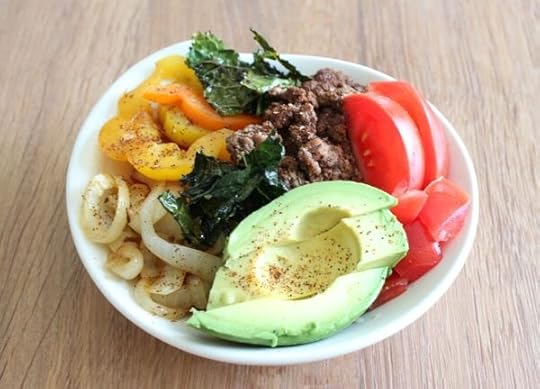 One-bowl meals, like this taco bowl, are a great example of achieving maximum flavor with minimal effort. When all the ingredients for a meal are piled on top of each other in a bowl, every bite brings a delicious new combination of flavor. Plus, every bite is packed with protein, healthy fat, and a variety of vegetables. And, it’s ridiculously easy to make.
One-bowl meals, like this taco bowl, are a great example of achieving maximum flavor with minimal effort. When all the ingredients for a meal are piled on top of each other in a bowl, every bite brings a delicious new combination of flavor. Plus, every bite is packed with protein, healthy fat, and a variety of vegetables. And, it’s ridiculously easy to make.
Start by mixing up a batch of taco seasoning. It’s a bold but not overpowering spice blend that can be used to season any type of meat, or vegetable for that matter. Double the recipe if you like, then store extra in your spice drawer to season other meals.
Next, slice up a variety of peppers and an onion and saute them in the same pan as the seasoned meat. Then gather up your garnishes. Avocado and tomato are a must for a taco bowl. Baked kale chips are optional, but add the perfect crunch. You could stop there if you wanted to, but why? The beauty of a one-bowl meal is that the more ingredients you add, the better it tastes. Cilantro, mixed greens, salsa, grated cheese, sour cream, black olives, green onions…dig through your kitchen and add whatever sounds good.
Pile everything high in a bowl, grab a fork and sit down to eat. In 20 minutes or less you’ve just made an incredibly delicious meal without breaking a sweat.
Servings: 3-4
Ingredients:
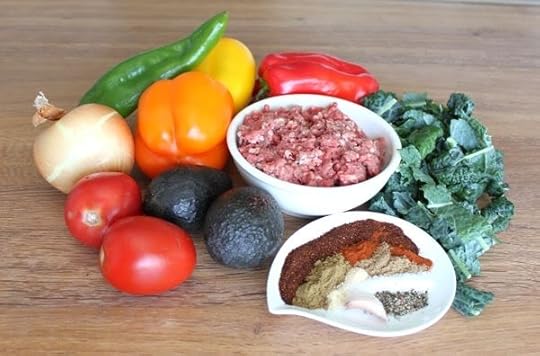
Taco Seasoning
1 tablespoon chili powder
1 teaspoon cumin
1 teaspoon paprika
1/2 teaspoon coriander
1/4 teaspoon onion powder
1/4 teaspoon garlic powder or a few minced garlic cloves
1/2 teaspoon salt
1/2 teaspoon black pepper
Taco Bowl
1 pound of ground or thinly sliced meat
1 to 2 onions, thinly sliced
3 bell peppers, sliced
1 or 2 other peppers such as Anaheim, poblano or jalapeno, sliced (optional)
2 avocados, sliced
2 to 3 tomatoes, roughly chopped
1 small head of kale
Optional garnishes: cilantro, mixed greens, cheese, sour cream, salsa, green onions, black olives, etc.
Instructions:
Mix together the taco seasoning spices. Set aside.
To make the kale chips, preheat the oven to 300 degrees Fahrenheit. Remove the stems and separate the leaves from the tough center rib. Rip or cut the leaves into small pieces then toss with olive oil and a few pinches of taco seasoning. Bake the leaves in a single layer – this is important because if you crowd too many into one pan they won’t get as crisp. Bake for about 20 minutes until leaves are crisp and easily crumble.
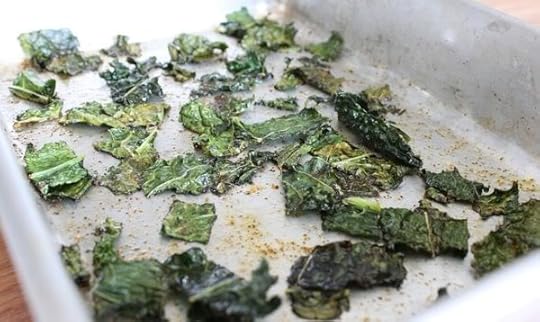
While the kale chips bake, sprinkle the rest of the taco seasoning on the meat.
In a large skillet over medium-high heat warm a few tablespoons of oil and saute the onion just a few minutes. Add the bell peppers to the skillet. Saute about five minutes more until the onion and peppers are brown around the edges and a little bit soft.
Add the meat. Saute with the veggies until cooked.

In serving bowls, combine the meat, peppers and onion with avocado and tomato. Top with kale chips and other garnishes.
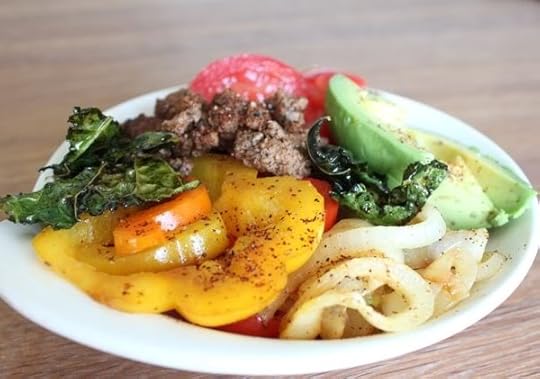
Grab a copy of Primal Blueprint Quick & Easy Meals for over 100 Primal Recipes You Can Prepare in 30 Minutes or Less

June 22, 2012
What Does It Mean to Be a Fat-Burning Beast?
It’s Friday, everyone! And that means another Primal Blueprint Real Life Story from a Mark’s Daily Apple reader. I’m excited to be able to bring you this story today. As much as I’m not a fan of Chronic Cardio, I understand that a lot of people are interested in pursuing endurance events. I get it. I used to be one of them. More and more, now, I’m convinced there is a way to do it in a low-carb environment without sacrificing health, and I’m working on a book due out at the end of next year entitled “Primal Endurance” that explores how to do it. Stay tuned!
If you have your own success story and would like to share it with me and the Mark’s Daily Apple community please contact me here. I’ll continue to publish these each Friday as long as they keep coming in. Thank you for reading!
 My wife Cynthia and I embarked on a six month journey and discovered what it means to be Fat-Burning Beasts. We have been intrigued with discovering answers to questions like “what is the protocol, how would we know if we have achieved Fat-Burning Beast status, what is the body’s response, and ultimately, how far can one push the limits of a Fat-Burning Beast? On our journey in answering these questions, we lost weight…our percent body fat dipping by 7 points, we improved sleep, seasonal allergies all but disappeared and we improved our mental acuity. But the greatest gift of all has been passing on the keys to better health and ultimately happiness to family, friends, and co-workers who we have inspired enough to explore for themselves the Primal Blueprint.
My wife Cynthia and I embarked on a six month journey and discovered what it means to be Fat-Burning Beasts. We have been intrigued with discovering answers to questions like “what is the protocol, how would we know if we have achieved Fat-Burning Beast status, what is the body’s response, and ultimately, how far can one push the limits of a Fat-Burning Beast? On our journey in answering these questions, we lost weight…our percent body fat dipping by 7 points, we improved sleep, seasonal allergies all but disappeared and we improved our mental acuity. But the greatest gift of all has been passing on the keys to better health and ultimately happiness to family, friends, and co-workers who we have inspired enough to explore for themselves the Primal Blueprint.
Before we begin, a short introduction of our Primal journey to date is in order. Cynthia and I consider ourselves triathletes. Mind you not to the stature of Mark Sisson’s trophy room, but accomplished in our own right with a combined 35 years experience culminating in 25 Ironmans combined with the last two of these scheduled for later this summer. Over the years, we have come to center our lifestyle to compete at multiple distances with a typical gearing up in early spring, racing through October and taking off two months to enjoy the holidays (or season of gluttony). Interestingly enough, every year it has been the two short months of November and December which have caused us greatest concern in reflection. Pre-Primal we would indulge ourselves with all of the grain-laden, sugary-coated treats packing on 15 to 25 pounds each only to find ourselves feeling miserable by January and looking for ways to drop the weight. It was this past January where we once again found ourselves struggling in miserable physical condition and embarking on a new year of training. We were again researching for ways to best lose the effortlessly gained weight. Yes, effortlessly gained.

After hours of internet searching through all of the so called diets, we ultimately landed on Mark’s Daily Apple. Cynthia and I are trained scientists who were completely amazed by the information we were reading about The Primal Blueprint. It all seemed to make sense biologically, and besides, who doesn’t like bacon? We were hooked from the beginning. We even traveled to PrimalCon 2012 traveling across the country where we could meet the Guru Mark himself along with so many other amazing individuals seeking (and finding) good health with an ancestral approach to eating and playing. As it turns out, this conference changed our beliefs for living and has further solidified this new (old) lifestyle we were adopting.
Skipping ahead in our story, we have been Primal for 6 strong months and have found our race focus changing for this year. We no longer focus on a PR, but more so on how to do a race Primally, with clean energy, and to get in touch with our inner spiritual selves, ultimately accomplishing the same distances with less training and more fun time. Who wouldn’t like that? Our bodies, as many of you have discovered for yourselves, have changed in so many ways. Of course we lost our effortlessly gained holiday weight, but we also realized more advantages. As I said, our percent body fat dipping by 7 points, improved sleep, seasonal allergies all but eradicated, more motivated, and improved mental acuity (we think…).
So let’s talk about being keto-adapted. Our first opportunity to test and see if we achieved Fat-Burning Beast status arrived late April in the form of a marathon. Up to this point, many of our longer training runs consisted of fueling with a typical low-carb (50 g or under) Primal meal the evening prior and training the following morning in a fasted state (no breakfast and no gels/bars to fuel during). We learned very early on in our Ironman training the importance of maintaining electrolyte balance to avoid cramping or even worse, hyponatremia). We found running on coconut water (VitaCoco) contained the perfect balance of hydration and electrolytes…yes we know it is low in sodium so we carried salt/electrolyte tabs just in case. But how would we fuel on race day? Our next struggle was to answer this question as our marathon quickly approached. From our readings and discussions with others online, we decided to add additional carbs the few nights leading into the event with acceptable starchy tubers such as sweet potatoes to fill our muscle glycogen stores. We also decided we would use gels and drink the offered course “sports” beverage (Gator…you-know-what) to fuel during the event. We struggled with accepting our decided meal plan and fueling because ultimately we did not feel we were remaining Primal. As it turns out, our plan was a big mistake! We both found ourselves “bloated” at the start line by having rapidly increased our daily carb count with sweet potatoes. Our bodies simply were not adapted to the unexpected surge. The gels and on-course sports beverages were equally a poor choice. Coincidentally, we both were bonking by mile 15. This was unexpected and not experienced in our low-carb training for the race. Even worse, for days following we both felt horrible with a distended bloating feeling in our guts. We simply had shifted our metabolisms to a keto-adapted low-carb state and confused our bodies by asking them to process the added sugars/starches.
From what we had read, we were supposed to digest the carbs and gels with no issue since we would be pushing ourselves to our aerobic limits as we attempted to PR. Not wanting to feel this way again, we decided to test the other side of this equation. Again, from our readings we learned individuals with a body fat of 10% has access to over 40,000 kcal from body fat alone as compared to the average sugar-burner with access to 2,000 kcal in the form of stored glycogen (J.Volek, S. Phinney; The Art and Science of Low Carbohydrate Performance). The “trick” to utilizing this plethora of energy would be to remain in a controlled aerobic keto-adapted state, which we would gauge by being able to comfortably carry on a conversation during the event. Coincidentally, many of our training runs were accomplished in this manner (who knew?). Adding to the challenge of being a Fat-Burning Beast, we decided to compete in a fasted state during the event after eating a standard Primal dinner of good fats, proteins and vegetables the evening prior. By doing so, we would be assuring our energy supplies were in fact due to our keto-adapted abilities. We would later call this Primal endurance. Unlike our ability to open the refrigerator to a smorgasbord of meats and vegetables, I’m sure Grok had to deal without fueling from time to time.
Our first Primal endurance test was a half Ironman just a few weeks ago. Incredibly, we competed in this fasted state only taking on water and electrolyte tabs for the entire event. By gauging where our aerobic threshold was and keeping our effort slightly below, we were able to comfortably finish without putting in any of the sugary gels, liquids and without the typical carbo-loading pasta party the night prior. Naturally, we would not experience a PR but hopefully something much more (in our opinion) magical…the ability to be master of our metabolisms. Not only did we finish in a strong state, this particular event offered roasted chicken, salad greens and fruits, at the finish line…simply heaven for Primal Fat-Burning Beasts like us. Whoo hoo! We even ate hunks of butter meant to accompany the bread basket (without the bread of course!). After finishing our Primal fare, we loaded our bikes up, drove 7 hours home arriving after midnight, and arrived on time at work the following day. We asked ourselves, could a sugar-burner have “burned the candle” on both ends as we have? We obviously felt incredibly better as compared to our sugar-carb laden race experience earlier in the year.
So what about recovery you ask? Well, I had an annual bike ride I’ve participated in for a few years now planned for the following Saturday (only six day later). Oh yeah, the ride was from High Point, NJ to Cape May, NJ in a day (207 miles). Unfortunately, Cynthia could not join in the fun since she had to stay home and take care of our four Show Boxers and old lab mix (but that’s another story). Wondering if I could expand my personal Primal endurance time, I repeated the experiment. This time, however, I doubled the exercise while fasting time and covered 12 hours worth of cycling on mostly water, coconut water, and electrolyte tabs. I had pedaled 170 miles before partaking in what was the most delicious tasting avocado, bacon, grass-fed burger ever (without the bun of course). It is amazing how the taste buds come to life after a long fasting. I am perfectly content accepting a slightly slower pace while staying in the aerobic zone so long as I can remain Primal. Furthermore, our future goals include increasing our aerobic threshold in order to compete at even higher intensities while remaining keto-adapted. In the beginning, we were of course skeptical as we felt drained and tired as our bodies were morphing from our sugar-burning days into capable Fat-Burning Beasts. It’s a process where small modifications over time can help achieve success. We do not use the 80/20 rule as we have found we feel better and don’t feel the need for the “20” simply because we feel so good. Cynthia and I are not sure where this journey will take us other than knowing we have experienced feeling super fit and healthy all while training less and being true to our Primal selves.
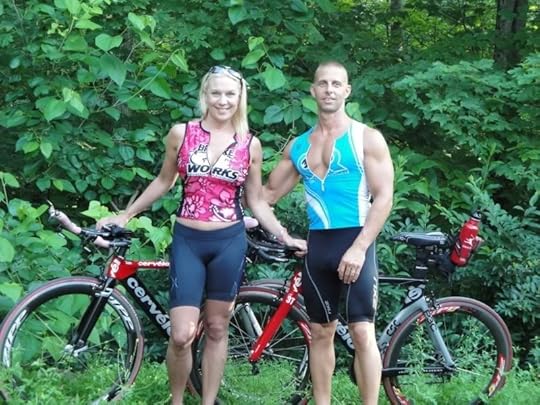
In the short six months we have been Primal, we have been most humbled by the number of family, friends, and co-workers we have inspired to explore the Primal Blueprint for themselves. Perhaps this is the greatest gift of all – passing on the keys to better health, and ultimately happiness. We have personally witnessed others reclaim their health, drop medications, and in general, just feel better about themselves. Life is good.
Wishing you all many success stories of your own and to those you may “pay it forward” to.
Visit Mark’s Daily Apple on Wednesday, June 27, to Grab Your Copy of the Upcoming Book The Primal Blueprint 90-Day Journal and Claim Your Free Gifts!

June 21, 2012
How to Conduct a Personal Experiment: Yellow Light Exposure (plus an Announcement)
 You guys ready for another personal experiment? I hope so. Even if don’t think you’re ready to take something on, I’m confident you’ll be able to handle this one, because it’s relatively simple, intuitive, and easy. It’s also something I’ve been discussing for a couple years now, so you’re most likely familiar and comfortable with the concept. But most importantly, today’s experiment is a gentle one that requires very little commitment. No jumping in freezing cold water, no drastic changes to your sleeping schedule. All I’m asking you to do is experiment with nighttime yellow light exposure.
You guys ready for another personal experiment? I hope so. Even if don’t think you’re ready to take something on, I’m confident you’ll be able to handle this one, because it’s relatively simple, intuitive, and easy. It’s also something I’ve been discussing for a couple years now, so you’re most likely familiar and comfortable with the concept. But most importantly, today’s experiment is a gentle one that requires very little commitment. No jumping in freezing cold water, no drastic changes to your sleeping schedule. All I’m asking you to do is experiment with nighttime yellow light exposure.
Huh?
Remember how I wrote about nighttime exposure to blue light affecting melatonin secretion and, subsequently, sleep quality and duration way back when? Yeah, that. In case you didn’t read it, I’ll give a quick explanation:
The color (or wavelength) of the light we perceive entrains, or “sets,” our biological clocks, also known as circadian rhythms. And in the natural environment, with its reliably consistent lighting schedule, it works pretty well. During the day, we see all the visible wavelengths provided by the sun, including violet, blue, green, yellow, orange, and red light, and this “tells” our bodies that it’s daytime, that’s it’s time to be active, to hunt, to gather, to build, to work, to exercise, to study, and so on. Secretion of melatonin, the “sleepy hormone,” is blunted. At night, when the only visible light is historically the longer wavelengths, the yellows, oranges, and reds which we create through campfires, or candles, or gas lamps, melatonin secretion is unaffected. We get sleepy like we should, when we should. All is well. And if we had evolved to be nocturnal, like rats, all that low-wavelength blue light exposure available during the day would let us know it’s time to sleep.
But we don’t use candles and oil lamps at night anymore, do we? We use white LED lights (blue light) and stare into laptop (blue light) and high-def TV (blue light) screens. We use our iPhones (blue light) or Androids (blue light) in bed, even waking up in the middle of the night just to check our email (blue light) because “why not, we’re up anyway!” To really get a sense of this, next time you take a nighttime stroll around your neighborhood, pay attention to the living rooms of the houses you walk past. If they’re got their plasma or LCD going, the lights off, and it’s dark out, the entire room will be bathed in an overpowering blue light. It’ll look like a scene from an alien abduction movie or something. Of course, whether the room lights are on or off, that blue light from the screen is still there, beaming directly into the eyes of those present and affecting the secretion of their melatonin.
And we wonder why we have so much trouble getting good sleep.
It’s not just sleep that’s affected (although that’s enough reason to take heed). Disturbing our circadian rhythms with improper light exposure may have a range of other health effects, including, but not limited to:
Increased risk of breast cancer. The presence of greater amounts of melatonin in morning urine (an indicator of normal melatonin secretion at night) is linked to lower breast cancer rates in women, and a rat study seems to provide a mechanism.
Increased susceptibility to skin cancer. As Jamie points out here, our ability to withstand the sun’s rays and repair any UV damage done to our skin depends on a functioning circadian rhythm.
Increased risk of metabolic syndrome and obesity-related diseases. Disrupted circadian rhythms, light-at-night suppression of melatonin secretion, and poor sleep have been linked to metabolic syndrome. In the past, I’ve explained how bad sleep can make you and your liver fat.
When I say “yellow light exposure,” what I’m really talking about is “blue light avoidance.” Today, I’m going to show you how to put together an experiment to test the effects of exposing yourself to yellow/orange/red light and avoiding blue light. Although that sounds like we’re testing two things, we’re really not, since yellow light has little to no effect on our melatonin production. For all intents and purposes, it and other, higher wavelength lights are neutral, while blue light is antagonistic to our circadian rhythms.
Okay, so how do I do it?
First, choose a goal that yellow light exposure and blue light avoidance might help make possible. Since we can’t really test our susceptibility to cancer in a short trial, nor does metabolic syndrome develop in mere weeks, let’s test the effect of yellow light exposure (and blue light avoidance) on some aspect of our sleep.
“I want to feel more refreshed in the morning.”
“I want to go to bed by 10 PM every night.”
“I want to have more melatonin in my morning urine” would be an effective way to test, but it also requires being able to test your urine for melatonin. Most people don’t have that on hand. Let’s go with the second one – getting sleepy and in bed by 10 every night – since that’s easy to quantify (did you go to bed at 10?). If you already go to bed at 10 PM, choose a time that’s earlier than your normal bedtime. The key is to find out if you get sleepy earlier without the blue light.
Come up with a hypothesis, such as:
“Since blue light exposure suppresses normal melatonin secretion, and melatonin makes us sleepy, exposing myself to yellow light and avoiding blue light after dark will help me get sleepy and go to bed by 10 PM.”
Next, identify some of the variables that could affect the results of your experiment:
Activity at night – Does what you do while avoiding blue light affect your sleepiness? Is reading more stimulating than hanging out with your spouse?
Electronics usage – Assuming you’ve taken steps to eliminate blue light exposure (wearing blue light-blocking goggles, installing f.lux on your computers), do electronics still stimulate you and keep you awake?
Yellow light source – Does a yellow light bulb act differently on you than candlelight?
Then, let’s take some measurements. What should you be measuring?
Bedtime – When did you get into bed?
Sleepytime – When did you start getting noticeably sleepy? Time of first yawn?
Sleeptime – When did you fall asleep? This is hard to measure without equipment, but you can probably approximate it. Personally, once I get too tired to read another page and find myself nodding off in the middle of a sentence, that’s my sleeptime, because I fall asleep as soon as I put the book down and turn off the (yellow) light.
Morning wakefulness – On a scale of 1-10, how awake and refreshed do you feel in the morning?
After a few weeks you should have enough data to start making some observations about what does and doesn’t work for you, and from there you can decide on what to test next, if anything. That’s it for this experiment. Have fun!
Thus concludes this short but sweet series on self-experimentation. What’d you think? I for one am a firm believer in the power of the self-experiment. In fact, I think it’s the ultimate arbiter of an individual’s ideal path to health. Sure, you could read all the blog posts and studies and papers and research in the world, but if you personally experienced results that completely contradicted the advice of the experts, what would you do? Would you continue down the path that supposedly worked for this cohort or that quadrant of some population somewhere? Or would you stick with what worked for you?
Exactly; we are complex beings with physiological processes that even the experts who study them for their entire lives don’t fully understand. Everyone is different, and there are no real one-size-fits-all plans – not any honest ones, at least – and so self-experimentation (even if it’s just an informal thing) is absolutely crucial and highly effective.
In case you missed the newsletter announcement this week: next Wednesday, my new book, The Primal Blueprint 90-Day Journal, is being released! As usual, there will be a very special early-bird offer. I’ll be throwing in some limited-time freebies, and doing a big day-of announcement, so check back here on June 27 and be ready to take advantage of the offer.
Now let’s hear from you. If you have any questions or comments about this self-experimentation series, leave them in the comment section and if there are enough questions, I’ll do a Dear Mark on self-experimentation next week. Thanks for reading!
Grab a copy of Primal Blueprint Quick & Easy Meals for over 100 Primal Recipes You Can Prepare in 30 Minutes or Less

June 20, 2012
Is It Primal? – Cod Liver Oil, Sunflower Butter, Mead, and Other Foods Scrutinized
 It’s time for another round of “Is It Primal?” This time, I’ll be covering six questionable foods. First, I tackle whether or not cod liver oil has a place in a Primal eater’s pantry (or fridge), and whether standard cod liver oil is worth it. Then, I get into the suitability of mead, that honey wine popularized by the Vikings, followed by maple syrup. Is it another “safer sweetener,” just like honey, or is it sugar masquerading as a health food? After maple syrup, I dig into pectin, binder of jam and jelly; and sunflower butter, also known as sunbutter, a popular replacement for peanut butter. Finally, I scrutinize the food about which literally everyone in the Primal blogosphere has been wondering, the food that’s getting an entire panel at the 2012 Ancestral Health Symposium, the food that we’ve all been eying in the meat section: camel meat.
It’s time for another round of “Is It Primal?” This time, I’ll be covering six questionable foods. First, I tackle whether or not cod liver oil has a place in a Primal eater’s pantry (or fridge), and whether standard cod liver oil is worth it. Then, I get into the suitability of mead, that honey wine popularized by the Vikings, followed by maple syrup. Is it another “safer sweetener,” just like honey, or is it sugar masquerading as a health food? After maple syrup, I dig into pectin, binder of jam and jelly; and sunflower butter, also known as sunbutter, a popular replacement for peanut butter. Finally, I scrutinize the food about which literally everyone in the Primal blogosphere has been wondering, the food that’s getting an entire panel at the 2012 Ancestral Health Symposium, the food that we’ve all been eying in the meat section: camel meat.
Let’s get to it.
Cod Liver Oil
This one’s easy to answer. Cod? It’s a rather lean fish from colder northern waters – definitely Primal. Liver? It’s harder to get more Primal than liver, to be honest. And although processed seed/vegetable/hydrogenated oils aren’t Primal, most other oils, like coconut, olive, and palm, come highly recommended. So, yes, cod liver oil is Primal.
But what we’re really wondering is whether or not we should eat the stuff. Should we?
Perhaps. Cod liver oil is a fish oil, so it’s a good source of omega-3 fatty acids, particularly EPA and DHA. If we’re not regularly eating fatty fish, we should be adding a supplementary source of omega-3s to our diets. Cod liver can be that supplementary source. However, cod liver oil isn’t just a way to get omega-3s; it’s also rich in vitamin A and vitamin D. In fact, in cold northern climates that get little sunshine, cod liver oil was (historically) a common way for people to obtain enough vitamin D to avoid rickets and other maladies. I wouldn’t rely on it solely for my vitamin D requirements, but it can provide a nice whopping dose of pre-formed vitamin A for those who don’t eat animal liver.
And as Chris Kresser said, cod liver oil is a sacred superfood for fertility and pregnancy. However, he recommends the fermented cod liver oil from Green Pastures, which is cold-treated, rather than heat-treated, and contains only the vitamin A and vitamin D naturally found in fish liver. Many people suspect other cod liver oil brands use synthetic vitamin A, which acts differently than foods that contain vitamin A.
Verdict: Primal.
Mead
If any alcohol is Primal – and I’d argue that moderate alcohol consumption absolutely has a place in many a Primal living plan, including my own - then mead, or honey wine, must also be included. Why?
With evidence of production as far back as 9000 years, mead was likely the first alcoholic beverage produced by humans (that reads a bit like I’m suggesting other animals, or perhaps aliens, produced alcohol before us, doesn’t it?). Even if you don’t accept that admittedly biased source of information (GotMead.com, really?), the fact remains that humans have been eating honey for tens of thousands of years. Somewhere, sometime, Grok must have left a stash of honey out a bit too long and had it ferment on him. After tentatively tasting enough of the bubbly, funny-looking result and enjoying the effects, this would become a regular thing. This is speculation of course, and it doesn’t mean mead is good for us, but I’d argue that we certainly have a long-standing tradition of enjoying fermented honey-based beverages. And that has to count for something, doesn’t it?
Seriously, though: if you’re okay with honey and alcohol, mead is a decent option. It’s gluten-free, at least, and contains a fair amount of antioxidant activity (less than red wine, but more than white wine or a disgusting concoction known as “soy-mead”).
Verdict: Primal as much as any alcohol is Primal, especially if it’s the Mead of Poetry, made from the blood of the wise Norse god Kvasi, which turns its drinker into a great poet and scholar.
Maple Syrup
Sugar’s sugar’s sugar, right? That’s often the general message floating around our circle, but I’m not sure it’s entirely correct. After all, fruit has sugar, but it’s also got fiber and phytochemicals and vitamins and minerals, and it’s handled differently in the body than, say, a bottle of fizzy HFCS. Same goes for honey, for which I did an entire post where the basic conclusion was that honey was a “safer sweetener” than plain white sugar. Then again, something being “natural” doesn’t make it healthier, as is the case with agave nectar; a previous “Is it Primal?” revealed that agave nectar is treated just like sugar and HFCS in the body and that raw white sugar actually contains more antioxidants than the vegan sweetheart. Which brings us to maple syrup – where does it stand?
Well, maple syrup defeats agave nectar and white sugar in the antioxidant department, but that’s not very difficult. It’s also been eaten for centuries as a traditional food, perhaps even longer, since the native Americans were producing maple syrup when the Europeans arrived in the Americas. A recent study identified 54 phenolic compounds in real maple syrup, including one dubbed quebecol that actually forms during the process of boiling sap down into syrup. Since honey owes its unique metabolic effects to the presence of dozens upon dozens of phenolic compounds, I would guess that maple syrup is one of the safer sweeteners.
When it comes to sugar, all maple syrups, regardless of the grade, are almost entirely sucrose. Grade B maple syrup, however, is darker, richer, more complex, and contains more minerals (and, probably just like the darker honeys, more phytochemicals). Go for grade B (whose name may change in 2013), and make sure you get real maple syrup, not just “syrup.”
Verdict: Primal limbo, but use caution, as it’s still sugar.
Pectin
Although it is used to gel up any number of ultra-sweet jams, jellies, and fruit-based desserts that generally aren’t Primal, pectin is an innocent bystander. Sure, it enables the production of sticky sweets, but you can’t really blame pectin for its inherent gelatinizing ability. It’s just a soluble plant fiber, a prebiotic that happens to be a cornerstone of the Smucker’s empire. As such, it has some interesting effects on the human metabolism upon ingestion:
Like with most prebiotics, fermentation of pectin by gut flora can result in the production of butyric acid, a short-chain fatty acid with benefits to our metabolic health.
Pectin lowers LDL cholesterol, which may not mean much if it’s not also lowering total LDL-P (particle number), but it probably doesn’t hurt. Oh, and it’s better than wheat fiber at lowering cholesterol.
Pectin also reduces the postprandial insulin and blood glucose responses to meals containing carbohydrates.
Despite the above effects, do I recommend going out and buying pectin packets to use as supplements? Not really. Just eat fruit and vegetables, which are the richest sources of pectin in our diets, and you’ll likely reap the benefits. I suppose you could also try making some low-sugar jam, especially if you’re the type of lucky dog to have an entire forest of wild raspberries at your disposal.
Verdict: Primal, depending on where you get it.
Sunflower Butter
In response to the epidemic of peanut allergy among the nation’s children and the first commercial attempts at a replacement being miserable, disgusting failures, the Agricultural Research Center devised a worthy, safe replacement using sunflower seeds in place of peanuts. However, they didn’t just grind up some seeds, add a bit of salt, and call it a day. They were trying to replicate peanut butter – texture, taste, spreadability, everything – and that meant the use of additives and stabilizers. A 2005 paper (PDF) reveals how they arrived at the optimal sunflower butter: by roasting the seeds in soybean oil, adding salt, lots of sugar, and a healthy dose of hydrogenated cottonseed and canola oils to act as stabilizers. Sounds delicious, huh?
That said, not all sunflower butters are hydrogenated abominations. Health food and quality grocery stores will carry good stuff, or you could just make your own batch. Sunflower seeds, like most other seeds, are definitely Primal, albeit a little high in omega-6 for constant consumption. The thing about sunflower seeds is that they take work to eat. They’re self-limiting. You have to remove the shell and all you get is minimal payoff in the form of a tiny seed. If you’re doing sunflower butter, all you have to do is unscrew the top and you’ll be swimming in the stuff.
Verdict: Primal, but be careful with overdoing it. And watch your ingredients.
Camel Meat
This was my favorite option provided by you guys. Not sure why anyone would wonder about camel meat being Primal or not, but here goes.
Meat is meat, for the most part, and that goes for camel meat. It’s usually treated as a red meat, albeit a tough one that requires braising if you get an older animal (though meat from the younger camels is sweeter and more tender). High in iron, copper, and zinc, camel meat is like most other red meats in mineral content. Though camel meat is fairly lean (I’ve seen estimates of between 4-10% fat), the camel’s hump is almost entirely fat, primarily saturated and monounsaturated. Camel meat is about 44% saturated fat and camel hump fat is 60% saturated (mostly palmitic and stearic acid). I’d imagine you could let your local camel farmer know that you’ll “take all the humps your customers don’t want” and make a killing.
I’ve heard excellent things about the richness of camel milk. If you do dairy and have access to camel milk, try some. It’s incredibly creamy and has even shown anti-cancer effects in vitro.
One word of caution, however: know your source, especially if you plan on eating raw camel liver. You wouldn’t want to be the one guy in your circle of friends who comes down with bubonic plague, would you?
Verdict: Primal.
That’s it for today, folks. Be sure to write in with any other foods you’d like me to scrutinize. Take care and Grok on!
Grab The Primal Blueprint Cookbook Today and Receive Free S&H and a Free Primal Blueprint Poster

June 19, 2012
Dear Mark: Women and Intermittent Fasting
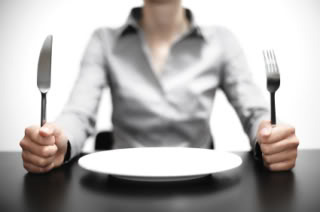 Many differences exist between the two sexes. We look different. We sound different. We dress differently from each other. We like different things. Different genres of movies cause men and women to cry (differently). And although society, media, and culture drive and/or inform many of our differences, some are inherent and physiologically-driven. For example, men and women have different biological equipment – both external and invisible to the naked eye – that change how we interact with and respond to our environments, our exercise, our sleep, and our eating habits. Nowhere are these gender differences more evident than in the realm of health and nutrition, and yet it seems that I’ve overlooked a big one: different sex responses to intermittent fasting.
Many differences exist between the two sexes. We look different. We sound different. We dress differently from each other. We like different things. Different genres of movies cause men and women to cry (differently). And although society, media, and culture drive and/or inform many of our differences, some are inherent and physiologically-driven. For example, men and women have different biological equipment – both external and invisible to the naked eye – that change how we interact with and respond to our environments, our exercise, our sleep, and our eating habits. Nowhere are these gender differences more evident than in the realm of health and nutrition, and yet it seems that I’ve overlooked a big one: different sex responses to intermittent fasting.
Let’s take a look at a couple recent reader emails:
Hi Mark,
I’m a woman (28 years old) who followed your recent fasting series with great interest, gave it a shot, but had mixed results. Then I read this post, which mentioned your series and questioned the suitability of intermittent fasting for women. Is it true? Do we respond differently than men? What do you think of that post? Thanks!
Claire
Dear Mark,
Paleo for Women blog says that fasting may not be for women: that it’s more suited for male physiology. I have been fasting for three years and never experienced any missed periods/sleeplessness, etc. Moreover I got a handle on my mindless eating. Can you give your word on IF for women?
Anon
Thanks for writing in with your questions.
First of all, I really, really liked Stefani’s post. I should say “posts,” actually, since Stefani Ruper (who wrote the post linked in the reader question) also just did a guest post on Free the Animal, in which she discussed the treatment of women’s issues in the community at large. While I don’t agree with everything she said, both were quite well done.
Even though her articles – for lack of a better phrase – “called me out” (in a completely non-confrontational way), I was actually quite happy to read them. Heck, I was happy to read them because of it. After all, I’ve always encourage people to be critical about what they think they know about nutrition and fitness, and to be skeptical about what they read on the Internet – my articles included. The beauty of MDA is that it isn’t one-sided. I get constant feedback from readers that send me down new paths of inquiry, and it’s through this kind of crowd-sourced effort that the Primal Blueprint message grows and becomes stronger than it already is.
I also appreciated Stefani’s articles because they do highlight a blindspot – not just in my own series of posts, but in nutritional science as a whole. In the push to eliminate the confounder known as inherent endocrine gender differences, they’ve forgotten that real life is a series of confounding variables all pushing, pulling, poking, and prodding at the results we get. They’ve forgotten that while their results may represent fodder for publishing and accolade accumulation and hypothesis confirmation (or rejection), real live humans in normal living situations are not placebo-controlled. That women are not the same as men and respond differently to stimuli and stressors isn’t a “confounder”; it’s a fact deserving of further study! Because what are we ultimately trying to do here – put together nice, neat, peer-review-ready trials, or help real people living real lives?
Since I’m trying to do the latter, I happily accept constructive criticism. So should we all.
So, what did Stefani’s research find?
Fasting has different endocrine effects on male and female rats.
In male rats:
No matter the duration or degree of nutritional stress, male rat brain chemistry responds with similar changes. Nocturnal activity and cognition stay fairly stable, regardless of the intensity of the fast. If you push the fast long enough, males will get a little wonky and frantic, but overall they maintain pretty well. It’s like they’re equipped with the ability to handle nutritional stressors.
In female rats:
Any degree of nutritional stress (fasting or mere caloric restriction) causes increased wakefulness (during the day, when they normally sleep), better cognition (for finding food), hyper alertness, and more energy. In short, female rats become better at finding and acquiring food when they fast, as if their bodies aren’t as well-equipped to deal with the stress of going without food. They also become less fertile, while the males actually become hornier and more fertile (probably to account for the females’ plummeting fertility). Ovary size drops (bad for fertility), adrenal gland size increases (which in rats indicates exposure to chronic stress), and menstrual cycles begin to dysregulate in proportion to the degree of caloric restriction.
In humans, the male-female fasting literature is quite scant, but Stefani also found considerable differences beween the sexes, when data was available:
One study, which I’ve cited before as evidence of a benefit to fasting, found that while IF improved insulin sensitivity in male subjects, female subjects saw no such improvement. In fact, the glucose tolerance of fasting women actually worsened. Ouch.
Another study examined the effect of alternate day fasting on blood lipids. Women’s HDL improved and their triglycerides remained stable; men’s HDL remained stable and their triglycerides decreased. Favorable, albeit sex-specific results.
Later, both obese men and women dropped body fat, body weight, blood pressure, total cholesterol, LDL cholesterol, and triglyercides on a fasting regimen. These people were obese, however, and perimenopausal women were excluded from the study, so the results may not apply to leaner people or women of reproductive age.
I figured I’d look through my other recent fasting posts for data on female (preferably pre-menopausal) responses to fasting. Here’s what I found:
In the only heretofore extant human study on fasting and chemotherapy, seven females (including a 44-year old woman who was likely premenopausal, given when menopause usually onsets, though it wasn’t explicitly stated) and three males found that IF improved their tolerance to and recovery from chemotherapy. Takeaway: male and female (mostly middle aged, though that’s the population that generally gets cancer and undergoes chemotherapy) chemotherapy patients appear to benefit equally from IF.
Although both men and women displayed greater increases in VO2 max and resting muscle glycogen concentration in response to fasted cycling training, only men showed greater skeletal muscle adaptations when fasted. Women had better muscle adaptations when fed. Takeaway: fasted endurance training, then, may work better for women than fasted weight training.
As it stands right now, I’d be inclined to agree that pre-menopausal (and perhaps peri-menopausal) women are more likely to have poor – or at least different – experiences with intermittent fasting, at least as a weight loss tool. That said, it appears to be a potentially gender-neutral therapeutic tool for chemotherapy, cancer, and age-related neurodegeneration patients.
As I alluded to earlier, this is what I love about this open forum we call the Internet: the fact that if you leave something out, or overlook a key point, someone will call you out on it, most likely publicly. When that happens, you grow despite yourself. If not for Stefani’s posts, I may never have taken a closer look at the inherent differences in men’s and women’s metabolic responses to fasting. I certainly receive enough feedback from female readers for whom fasting has been helpful, so it’s good to see another side.
To sum things up – if such a thing can even be done – and answer the questions in the intro, men and women have inherent metabolic and hormonal differences, and it’s evident that these differences in part determine how we respond to a stressor like intermittent fasting. I’ve never prescribed intermittent fasting as a requisite piece of the Primal lifestyle, but rather as an adornment, a choice, a potentially therapeutic strategy that each individual must test for him or herself. Although my recent series on fasting might have thrown some people off, I want to reiterate that I am not a huge IF guy. For myself, I generally fast when it makes sense – if I’m traveling and good food isn’t available, if I’m just not hungry, stuff like that. I periodically do 16/8 or 14/10 (i.e. eating in an 8 or 10 hour window) and find it works great for me because I am fully fat-adapted. But even I don’t hold rigidly to that. It’s not for everyone. And that hasn’t changed.
So who should and shouldn’t consider fasting? Have my recommendations changed?
If you haven’t satisfied the usual IF “pre-reqs,” like being fat-adapted, getting good and sufficient sleep, minimizing or mitigating stress, and exercising well (not too much and not too little), you should not fast. The pre-reqs are absolutely crucial and non-negotiable, in my opinion, especially the fat-adaptation. In fact, I suspect that if an IF study was performed on sugar-burning women versus fat-adapted women, you’d see that the fat-burning beasts would perform better and suffer fewer (if any) maladaptations.
I would also caution against the already lean, already calorie-restricted woman jumping headfirst into IF. I mean, fasting is ultimately sending a message of scarcity to your body. That’s a powerful message that can get a powerful response from our bodies. If you’re already lean (which, depending on the degree of leanness, arguably sends a message of scarcity) and restricting calories (which definitely sends a message of scarcity), the response to fasting can be a little too powerful.
I’d also say that daily fasts, a la 16/8 or even 14/10, run the risk of becoming chronic stressors and should be approached with caution by women. Same goes for ultra-long fasts, like a 36 (or even 24) hour marathon. Most of all, though, I’d simply suggest that women interested in fasting be cautious, be self-aware, and only do so if it comes naturally. It shouldn’t be a struggle (for anyone, really). It shouldn’t stop your cycle or make it harder for you to get pregnant. It should improve your life, not make it worse. If you find that fasting has those negative effects, stop doing it. It should happen WHEN (When Hunger Ensues Naturally), if it happens at all.
I’m not going to say that women should or shouldn’t fast. I’ll just echo Stefani’s advice “to look at options, to be honest about priorities, and to listen to one’s body with awareness and love.” Frankly, everyone should be doing that, but with regards to fasting, it looks like women should probably hew a little closer to her words.
Of course, if I had to make one minor quibble with the content of Stefani’s otherwise outstanding posts, it would be her source for the number of unique visitors Mark’s Daily Apple gets each month. Nowadays, we’re actually getting closer to 1.5 million monthly uniques, not 250-300,000… but who’s counting?
That’s it for me, today. What about you? If you’re a woman who has tried fasting, or know someone who fits the description, let us all know about your experiences. I’m intensely curious to hear from as many of you as I can. Thanks for reading.
Get the Primal Blueprint Fitness eBook, Free Health Tips and Primal Recipes Delivered to Your Inbox

June 18, 2012
Is It Time to Retire the Low-Carb Diet “Fad”?
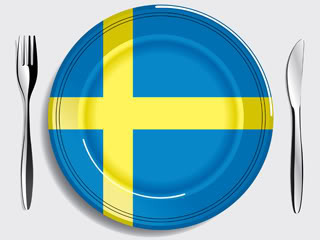 This is another special guest post from our favorite study-dismantler, Denise Minger. Read all of her previous Mark’s Daily Apple articles here, here, here, here and here, and pay her website a visit. Thanks, Denise, for clearing up the confusion once again!
This is another special guest post from our favorite study-dismantler, Denise Minger. Read all of her previous Mark’s Daily Apple articles here, here, here, here and here, and pay her website a visit. Thanks, Denise, for clearing up the confusion once again!
Sweden is a land of many wonders – most of which put the USA to shame. They’ve got fjords, ABBA, and caviar in a tube. And while Americans get arrested for things like DUIs and stealing socks from Walmart, Swedes get arrested for the more admirable feat of smuggling butter.
Such a delicious felony doesn’t reflect a life of crime so much as a life of fat – the edible kind. For nearly a decade, Sweden has been the unofficial headquarters of the Low Carb High Fat (LCHF) movement, churning out an unprecedented number of lipid lovers. In 2011, a whopping 25% of Sweden’s population was trying to eat more fat and curb their carbohydrate intake, with 5% of Swedes identifying as hardcore LCHF adherents. And those numbers only seem to be growing.
But a new study claims to cast doubt on the safety of Sweden’s fatward trend. In a paper published in Nutrition Journal last week (PDF available here), researchers linked the Swedish low-carb boom to rising cholesterol levels, increased heart disease risk, and failure to maintain long-term weight loss. A cascade of predictable headlines ensued, ranging from “Atkins diet found to be bad for the heart” to the brazen “Time to retire the low-carb diet fad.” The latter article – a well-circulated piece from The Atlantic – gave low-carb fans a particularly snarky flogging:
Low carbohydrate evangelists will almost certainly attack today’s announcement – and perhaps this post – with biblical fury. They’ll make their usual claim: that this is yet another conspiracy of scientists who just don’t get it, scientists who don’t understand nutrition, scientists who somehow made it through their PhD’s and MD’s without knowing the first thing about how the human body works. But let’s face it – most of us know in our hearts that eschewing a breakfast of whole grains and fruit crowned with a dab of yogurt for a greasy pile of sausage, bacon, and eggs is not the road to health.
Ouch! Time to whip out the granola and Yoplait?
If something seems fishy about this study, it’s not just the lutfisk: as usual, there’s more going on (or in this case, less going on) than the alarmist media would suggest. Here’s the real scoop.
No Low Carb, No Heart Disease
First and foremost, this study has nothing to do with low carbers, or even heart disease: it’s an observational study of Swedes Not Further Specified (SNFS). Researchers pulled 25 years’ worth of data from 140,000 folks in the North Sweden Diet Database, averaged everyone’s food intake, averaged everyone’s total cholesterol, and made some pretty graphs.
The findings? Sweden’s fat consumption (as a percent of total energy) dropped between 1986 and 1991, held steady until about 2004, and then started rising; the inverse happened with carbs:
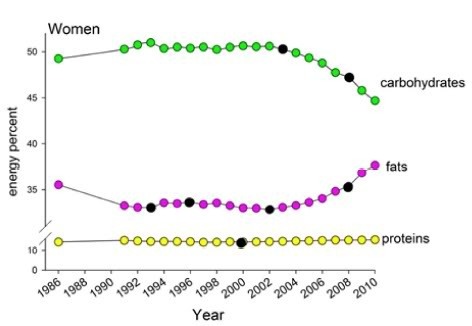
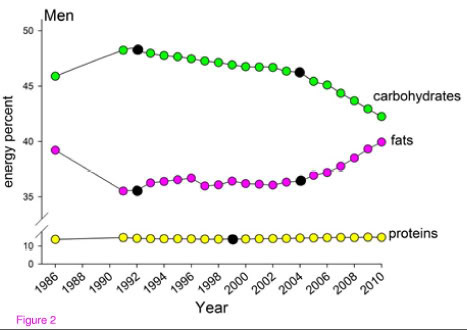
(In those early years, fat kerplunked due to the Vasterbotten Intervention Programme – a project launched in the mid ‘80s to encourage more physical activity, scoot Swedes towards a low-fat Mediterranean diet, improve food labeling, and hopefully knock heart disease off its tyrannous throne.)
And like an ant frantically evading the smoosh of a human thumb, average body mass index skittered wherever the heck it wanted (usually up):
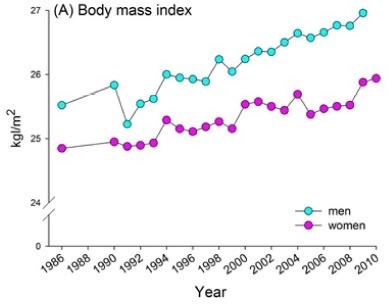
And average total cholesterol – not among low carbers, but among north Sweden’s general population – followed a roller-coaster-esque trajectory of its own. It plummeted between 1986 and 1992, crept back up until 1994, rolled downhill again until 2000, stabilized between 2002 and 2008, and then began yet another upward jog until the study ended. A visual for your viewing pleasure:
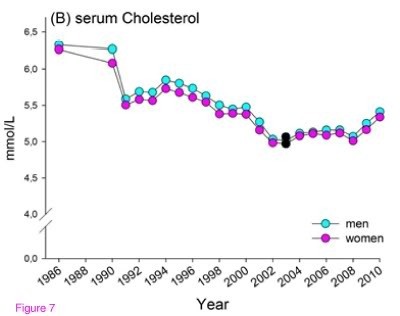
That’s it. No distinction between HDL and LDL, no reported triglycerides, and – most notably – no mention of how diet or cholesterol changes corresponded with actual heart disease rates. In fact, there’s nary a morbidity or mortality statistic to be found in the whole paper.
So how did the doom-and-gloom warnings about low carbing enter the scene?
Simple: the researchers think Sweden’s recent cholesterol hike might be a result of the LCHF boom – although the design of this study, with dieters of all persuasions stirred together in a giant pot of data-soup, makes it impossible to tell if that’s actually the case. Although the media apparently didn’t get the memo, the researchers even stated in their paper that “our study design does not allow a causal evaluation of the relationship between the increased fat intake since 2004 and the increased cholesterol values after 2007.” Likewise, the media thinks Sweden’s ever-increasing BMI, despite being an average of the general population, means that low-carb adherents fail to maintain their weight loss. (Yeah, I’m scratching my head over that logic too.)
Although it’s possible that saturated-fat-loving, low-carbing Swedes singlehandedly raised the nation’s average cholesterol in 2008, this seems iffy for a few reasons. For one, fat intake and blood cholesterol were hardly mirroring each other for the study’s previous 22 years: cholesterol levels continued to drop even when fat intake remained steady (though this could also be confounded by use of statins and ratios of specific fatty acids). Even more suspiciously, there was a four-to-six-year lag between the rise in fat consumption and the 2008 cholesterol jump – implying that Sweden’s fat-feasting took half a decade to affect blood values. (Usually cholesterol reflects diet changes in a matter of weeks.) And although this particular study tells us nada beyond “total cholesterol,” another paper published just a few months ago – drawing from the same pool of data – shows that after 2008, north Sweden’s triglycerides were frolicking uphill with cholesterol:
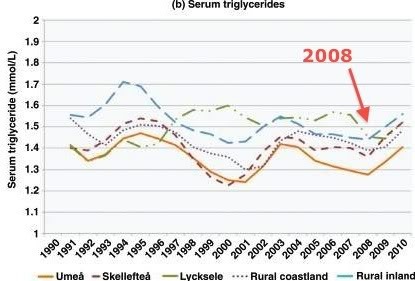
If that graph convinces anyone that the Low Carb High Fat movement is spiking triglycerides, I’ve got some oceanfront property in Arizona to sell ‘em, too: the evidence is pretty consistent that low carbing makes triglycerides sink. It seems more likely that other factors are lurking behind Sweden’s shifting blood lipid patterns, especially during the past few years.
Lo and behold, the fine print of our study-du-jour suggests the same. According to the researchers, foods associated with a high fat intake in Sweden were not just the predictable oils and meats, but also pizza, French fries, potato chips, corn chips, cheese-flavored puffed products, and popcorn, as well as “fats used for spreading on bread.” Unless Sweden has a very different definition of “low carb” than the rest of the world, it sounds like their fat intake isn’t coming solely from LCHF-approved fare, but from what most of us affectionately refer to as bona fide junk.
Even when it comes to foods directly associated with high cholesterol, Sweden’s low-carb movement still can’t shoulder all the blame. According to a supplementary table kindly included with the paper (available as a Word document here), boiled potatoes and coffee made bigger statistical contributions to blood cholesterol than saturated fat did! Other foods associated with high cholesterol included not just high-fat foods, but also low-carb no-gos like sweet buns, crisp bread, white bread, and sweet fruit soups.
Dairied Alive
Although this study doesn’t reveal anything very useful about what food does to us (particularly where fat is concerned), fear not: the diet-disease data for northern Sweden is a many splendored thing, and other studies have mined it with much more fruitful results. Or in some cases, milkful.
In 2010, the American Journal of Clinical Nutrition published a paper looking directly at dairy fat and myocardial infarction among some of the same northern Swedes used in last week’s study. The results? Women with high intakes of dairy fat – confirmed both by food-frequency questionnaires and ruminant-milk-fat biomarkers – were less likely to suffer from a first heart attack than their milk-minimizing counterparts. (Cheese and fermented dairy products looked particularly heart-protective.) And just in case you think that one was a fluke, a 2004 study examining the same Swedish population found dairy fat to be negatively associated with cardiovascular risk factors, with zero indication that full-fat milk products contribute to heart attacks. Want more? Yet another study (PDF), again based on those fat-loving northern Swedes, found dairy fat to be beautifully protective against strokes – especially in women.
So much for all that “artery clogging” hoopla!
Are Low Carbers in the Clear?
It’s a mystery why our current study tried to glean anything about low-carb diets from such tight-lipped data – especially since it’d be easy enough to actually untangle those low carbers from the rest of the population and follow them, up close and personal, like the stalkers we all secretly yearn to be. In fact, another north Sweden study published in February attempted that very feat (sans creepiness), and failed to find any increased mortality among the folks it deemed “low carb.” (Unfortunately, that study also used an invariably terrible diet-score design, but that’s a story for another day.)
As for Sweden’s recent cholesterol uppage? Without more detailed data and a look-see at disease rates, it’s virtually meaningless. But even if there’s no legitimate evidence dooming Swedish low carbers to an early grave, it’s possible that the LCHF movement is having some unhappy consequences in the Land of the Midnight Sun. The health climate there is clearly whipping fat-phobia into remission – which, despite the admirable triumph over bad science, could also breed a new species of half-hearted dieters like Low Carb Weekend Warriors, Low Carb As Long as There’s Not a Cookie in Front of Me, and Why Don’t I Just Put Butter on Everything Edible and Buy New Pants When They Get Too Tight. Folks who jump on the “high fat” bandwagon while still living in high-carb land may indeed find themselves gaining weight and frightening their doctors with ominous lipid panels. Whether or not this is happening in Sweden right now remains to be known, but it is a possibility.
Personally, though, I have other theories:
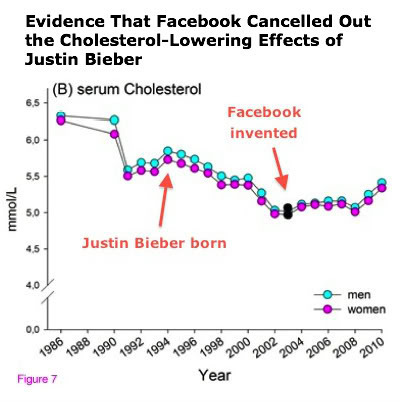
I’m not saying correlation equals causation. I’m just saying maybe we should think about switching to Google Plus.
Grab a Copy of Primal Blueprint Quick & Easy Meals Which Has Numerous Meals Featuring Red Meat That You Can Prepare in 30 Minutes or Less

June 17, 2012
Weekend Link Love
 Why our food is making us fat (hint: it’s not the fat).
Why our food is making us fat (hint: it’s not the fat).
How America’s grocery buying habits have changed – for the worse. Via NPR.
Also from NPR, “Commenters Bite Back on the Paleo Diet,” complete with a totally representative image of some guy eating a raw steak out of a paper bag (an unwitting foreshadowing of world where red meat is regulated and steak must be consumed clandestinely, perhaps?). This is a response to an earlier article which got taken apart by said commenters.
Hospitals in Europe (and, hopefully, elsewhere) are poised to roll out the world’s first quick, cheap, and accurate test for gluten intolerance.
While I’d personally prefer having R2D2 rolling alongside beside me, whirring and beeping encouragement as I lift, sprint, and train, I guess a flying exercise drone will have to do.
I’ve discussed how humans are hard-wired to be optimists before. Here’s a similar take on the evolutionary origins of optimism.
A pretty slick stand-up desk.
In yet another edition of “What Can’t Butter Do?”, Qualcomm discovers a novel way to test the thermal efficiency of their smartphone chips.
Recipe Corner
Jerk chicken is great, but why stop with birds? Throw some pork in there, too!
Some people don’t do white potatoes, while others have sweet potato intolerances. Everyone, however, loves them some squash. I present: squash fries.
Time Capsule
One year ago (June 17 – June 23)
The Art of Work: Avoiding the Pitfalls of a Sedentary Job – If you liked my post on working outside this week, you’ll probably something to like in this one, too.
A Beginner’s Guide to Backyard Chickens – Ideas on how to start your very own egg making company.
Comment of the Week
Blowing through your lips to make a “raspberry” or “horse lips” helps open the sphincters to ease release as well. It is also fun.
- Um, really, yoolieboolie?
Grab a Copy of The Primal Blueprint 21-Day Total Body Transformation and Start Getting Primal Today!

Mark Sisson's Blog
- Mark Sisson's profile
- 199 followers





